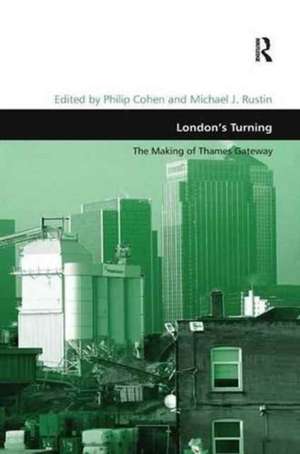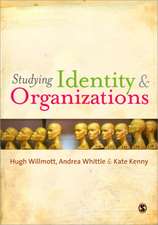London's Turning: The Making of Thames Gateway: Design and the Built Environment
Autor Michael J. Rustin Editat de Philip Cohenen Limba Engleză Paperback – 28 noi 2016
| Toate formatele și edițiile | Preț | Express |
|---|---|---|
| Paperback (1) | 469.34 lei 6-8 săpt. | |
| Taylor & Francis – 28 noi 2016 | 469.34 lei 6-8 săpt. | |
| Hardback (1) | 1065.78 lei 6-8 săpt. | |
| Taylor & Francis – 26 mar 2008 | 1065.78 lei 6-8 săpt. |
Din seria Design and the Built Environment
-
 Preț: 340.37 lei
Preț: 340.37 lei - 18%
 Preț: 1027.58 lei
Preț: 1027.58 lei - 13%
 Preț: 338.33 lei
Preț: 338.33 lei -
 Preț: 492.20 lei
Preț: 492.20 lei - 14%
 Preț: 338.33 lei
Preț: 338.33 lei -
 Preț: 469.34 lei
Preț: 469.34 lei - 13%
 Preț: 338.33 lei
Preț: 338.33 lei -
 Preț: 471.42 lei
Preț: 471.42 lei -
 Preț: 349.15 lei
Preț: 349.15 lei -
 Preț: 489.26 lei
Preț: 489.26 lei -
 Preț: 469.34 lei
Preț: 469.34 lei - 14%
 Preț: 260.54 lei
Preț: 260.54 lei - 12%
 Preț: 301.97 lei
Preț: 301.97 lei - 15%
 Preț: 259.10 lei
Preț: 259.10 lei - 12%
 Preț: 328.00 lei
Preț: 328.00 lei - 25%
 Preț: 827.24 lei
Preț: 827.24 lei - 30%
 Preț: 768.79 lei
Preț: 768.79 lei -
 Preț: 389.31 lei
Preț: 389.31 lei - 18%
 Preț: 1006.43 lei
Preț: 1006.43 lei - 26%
 Preț: 876.36 lei
Preț: 876.36 lei -
 Preț: 382.91 lei
Preț: 382.91 lei -
 Preț: 416.22 lei
Preț: 416.22 lei - 17%
 Preț: 246.33 lei
Preț: 246.33 lei - 28%
 Preț: 800.60 lei
Preț: 800.60 lei
Preț: 469.34 lei
Nou
Puncte Express: 704
Preț estimativ în valută:
89.81€ • 94.02$ • 74.31£
89.81€ • 94.02$ • 74.31£
Carte tipărită la comandă
Livrare economică 05-19 aprilie
Preluare comenzi: 021 569.72.76
Specificații
ISBN-13: 9781138266131
ISBN-10: 1138266132
Pagini: 356
Dimensiuni: 156 x 234 x 26 mm
Greutate: 0.45 kg
Ediția:1
Editura: Taylor & Francis
Colecția Routledge
Seria Design and the Built Environment
Locul publicării:Oxford, United Kingdom
ISBN-10: 1138266132
Pagini: 356
Dimensiuni: 156 x 234 x 26 mm
Greutate: 0.45 kg
Ediția:1
Editura: Taylor & Francis
Colecția Routledge
Seria Design and the Built Environment
Locul publicării:Oxford, United Kingdom
Cuprins
Contents: Preface; Editorial introduction, Philip Cohen and Michael J. Rustin; Part 1 Big Pictures, Small Details: Ex-ports: the laboratory role of London's docklands, Han Meyer; Smokestack: the industrial history of Thames Gateway, John Marriott; 120 years of regeneration, from East London to the Thames Gateway: fluctuations of housing type and city form, William Mann; Daring to plan? Concepts and models of urban regeneration in Thames Gateway, Michael Keith; Thames Gateway oxymorons: some reflections on 'sustainable communities' and neoliberal governance, Massimo De Angelis; Forcing the market, forging community: culture as social construction in the Thames gateway, Andrew Calcutt; Stuff happens: telling the story and doing the business in the making of Thames Gateway, Philip Cohen. Part 2 Case Studies in Urban Change: City to sea: some socio-demographic impacts of change in East London, Tim Butler, Chris Hamnett, Mark Ramsden and Sadiq Mir; Moving to a better place? Geographies of aspiration and anxiety in the Thames Gateway, Paul Watt; Homing in on housing, Penny Bernstock; 'Alright on the night'? Envisioning a 'night time economy' in the Thames Gateway, Karina Berzins and Iain MacRury; From bedsit-land to 'cultural hub': re-generating Southend-on-Sea, Gareth Millington; The Thames Gateway bridge: a new 'solution' to an old problem?, Andrew Blake; The airport next door; London City airport - regeneration, communities and networks, Iain MacRury; Involving local communities in the Thames Gateway developments, Alice Sampson; Blues sky over Bluewater?, Michael Edwards; After London's turning: prospects and legacies for Thames Gateway, Philip Cohen and Miichael J.Rustin; Index.
Notă biografică
Professor Philip Cohen is based at the Department of Urban Studies and Professor Michael J. Rustin, Department of Sociology London East Research Institute, University of East London, UK
Descriere
Providing a comprehensive overview and critique of the Thames Gateway plan, this volume examines the impact of urban planning and demographic change on East London's material and social environment. It also examines the immediate and longer term prospects for the Thames Gateway project both in relation to the 'Olympics effect' and the growth of new forms of regionalism.









